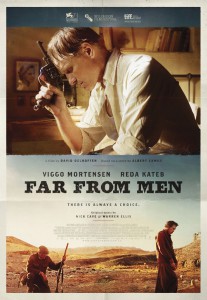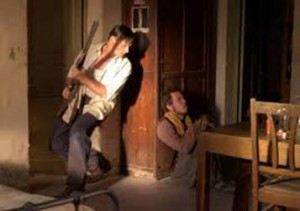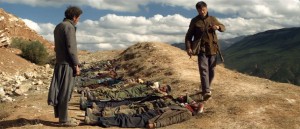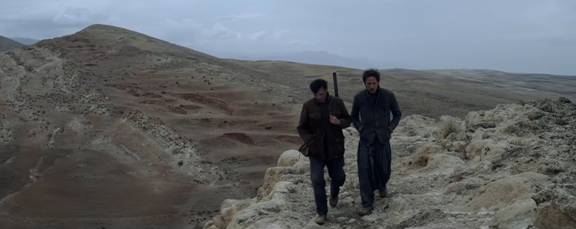Joshua Cole
University of Michigan
Albert Camus’s short story “L’Hôte” was published in 1957, in a collection entitled L’Exil et le royaume. From the barebones of this austere story about Algeria at the outset of the war of 1952-1961, David Oelhoffen has produced a remarkable film, Loin des hommes. Films based on texts often elide much of the detail that is not easily captured by a visual medium. In this case, however, the opposite is true: Loin des hommes adds much that is not present in “L’Hôte,” filling out characters, expanding the narrative, adding events, and most significantly, changing the ending. [Spoiler alert: read the story and watch the film before reading what follows—they are both well worth your time.]
“L’Hôte” tells the story of a schoolteacher, Daru, in a remote village in Algeria in the first days of the FLN’s insurrection in November 1954.The local gendarme asks Daru to escort an unnamed and bound prisoner—described as “an Arab”—to the district jail in a neighboring town.The man is not a nationalist rebel, but a simple murderer who has killed his cousin.The schoolteacher unties the man, and announces he will do no such thing.The gendarme nevertheless leaves the prisoner with Daru, and the two men spend an uneasy night together in Daru’s house.The schoolteacher and his prisoner wake the next morning and set off in the direction of the town.Before they reach their destination, Daru stops, and offers the prisoner a bundle of food and a small amount of cash.He points to two roads. The first leads to the district capital and the jail.The second, he says, leads south, to the “nomads.” “They will welcome you and give you shelter according to their law,” he says.The schoolteacher begins to walk back to his house, but after a few moments he turns in time to see the prisoner walking on the road towards the jail.When he gets back to his school, he finds a menacing message on the blackboard: “You turned in our brother.You will pay.” Camus’s story ends with Daru, isolated and alone, gazing on the Algerian landscape that “he loved so much.”
 The film departs from the story in significant ways. Above all, it is a beautifully rendered visual feast, taking every advantage of the medium to make the landscape a haunting presence in every scene.The sounds of the film are equally arresting, from the arid crunch of their boots on the rocky ground to the unobtrusive musical score (by Nick Cave) that accompanies the narrative.The film also differs from the story by giving the lives of these mysterious characters an arc, and gradually filling in the details that might explain who they are. Daru, played by Viggo Mortensen, is a widower still in mourning for his dead wife, the son of Spanish migrants who came to Algeria to work in the vineyards. He is also a veteran of World War II familiar with the weaponry of modern warfare, and the sounds and chaos of combat. One senses that his devotion to the Algerian children in his school is a form of payback, a kind of compensation for what he had been forced to do during the war. His unwillingness to take the prisoner to prison is a refusal to participate in the condemnation of another man, however guilty.
The film departs from the story in significant ways. Above all, it is a beautifully rendered visual feast, taking every advantage of the medium to make the landscape a haunting presence in every scene.The sounds of the film are equally arresting, from the arid crunch of their boots on the rocky ground to the unobtrusive musical score (by Nick Cave) that accompanies the narrative.The film also differs from the story by giving the lives of these mysterious characters an arc, and gradually filling in the details that might explain who they are. Daru, played by Viggo Mortensen, is a widower still in mourning for his dead wife, the son of Spanish migrants who came to Algeria to work in the vineyards. He is also a veteran of World War II familiar with the weaponry of modern warfare, and the sounds and chaos of combat. One senses that his devotion to the Algerian children in his school is a form of payback, a kind of compensation for what he had been forced to do during the war. His unwillingness to take the prisoner to prison is a refusal to participate in the condemnation of another man, however guilty.
In the film, the prisoner has a name. He is Mohamed, played with extraordinary restraint by Reda Kateb. This portrait of Mohamed is a welcome response to Camus’s notorious unwillingness to humanize the Arab characters in his fiction. Mohamed, as played by Kateb, is a sober young man, barely an adult. We learn that he has never slept with a woman, and that he did not want to kill his cousin. The film also reveals the logic behind his resignation, his unwillingness to run away: the brothers of his victim will take revenge on his family if he does not give himself up to the French police to face what both men agree is certain execution. Only with his death will his family be safe.
 Both men, then, struggle with the responsibility of having caused the death of others. Both suffer from what they have done, both seem to realize the absurdity of the all-too-human historical forces that led them to become killers, and both find an outlet in self-sacrifice, Mohamed in his acceptance of his fate, and Daru in the service of the children of the remote village who know nothing about his past. To hammer home this point, Oelhoffen stages another killing as the two men cross the arid and rocky landscape. Daru has armed himself for the journey, because of the danger of encountering nationalist rebels in the mountains. They encounter an armed Algerian man on horseback and in the ensuing confusion, Daru kills him with a single shot. Consumed with regret, he initially blames Mohamed for the death of the unknown man but the two men work together to bury the body and Daru stands by silently as Mohamed prays over the improvised tomb. From this moment, the two begin to grow together, in a fraternity born of mutual recognition, murderers in spite of themselves.
Both men, then, struggle with the responsibility of having caused the death of others. Both suffer from what they have done, both seem to realize the absurdity of the all-too-human historical forces that led them to become killers, and both find an outlet in self-sacrifice, Mohamed in his acceptance of his fate, and Daru in the service of the children of the remote village who know nothing about his past. To hammer home this point, Oelhoffen stages another killing as the two men cross the arid and rocky landscape. Daru has armed himself for the journey, because of the danger of encountering nationalist rebels in the mountains. They encounter an armed Algerian man on horseback and in the ensuing confusion, Daru kills him with a single shot. Consumed with regret, he initially blames Mohamed for the death of the unknown man but the two men work together to bury the body and Daru stands by silently as Mohamed prays over the improvised tomb. From this moment, the two begin to grow together, in a fraternity born of mutual recognition, murderers in spite of themselves.
Camus’s short story refuses overtly to relate the relationship between the two men to the political divisions that increasingly separated Algerians from the French after 1954, but the play of meanings in the title poses the question obliquely. “L’hôte” can mean either “host” or “guest” in French—and the story’s scenario refuses to announce which man plays which role. During the uncertain night, when the two men sleep together in the same room, Daru holding his revolver in his hand, the schoolteacher is obviously the “host,” but the larger dynamic of a disintegrating colonial society invites an inversion—it is the French, after all, who are the unwelcome guests in Algeria. And in the story’s last moments, when the prisoner refuses to accept Daru’s offer of freedom and trudges off to the jail, he is refusing the hospitality of the “nomads” whose law is to offer succor to strangers. Camus’s vocabulary refuses the language of politics, refuses to broach the question of national identity, and instead insists on the primacy of something more personal, the laws which force individuals to recognize the humanity of others, in spite of the distances that separate them.
 The filmmaker Oelfhoffen chose to broach the question of colonialism, nationalist struggle and the violence of decolonization more directly. Scenes at the beginning and the end offer a thoughtful reflection on the “civilizing mission” as Daru stands before the village children in the one-room schoolhouse and gives them their lessons on the geography of France and Algeria. In a sequence that does not appear in the story at all, he has Daru and Mohamed stumble on an armed group of Algerian nationalists in the mountains, organizing themselves for further attacks on the French settlers of the region. Daru even recognizes some of the men—they served together in Italy in the Second World War. Eventually, the group is attacked by a unit of French soldiers and the audience is treated to a textbook illustration of mid-twentieth century counter-insurgency techniques that also recall the tactics of the French military in the nineteenth century. The French army moves through the landscape with cold efficiency, bottling up the rebels in a cave, and shooting those who surrender without pausing to reflect on the consequences of their actions. When the firing stops, Daru and Mohamed are improbably allowed to continue on their way.
The filmmaker Oelfhoffen chose to broach the question of colonialism, nationalist struggle and the violence of decolonization more directly. Scenes at the beginning and the end offer a thoughtful reflection on the “civilizing mission” as Daru stands before the village children in the one-room schoolhouse and gives them their lessons on the geography of France and Algeria. In a sequence that does not appear in the story at all, he has Daru and Mohamed stumble on an armed group of Algerian nationalists in the mountains, organizing themselves for further attacks on the French settlers of the region. Daru even recognizes some of the men—they served together in Italy in the Second World War. Eventually, the group is attacked by a unit of French soldiers and the audience is treated to a textbook illustration of mid-twentieth century counter-insurgency techniques that also recall the tactics of the French military in the nineteenth century. The French army moves through the landscape with cold efficiency, bottling up the rebels in a cave, and shooting those who surrender without pausing to reflect on the consequences of their actions. When the firing stops, Daru and Mohamed are improbably allowed to continue on their way.
 These scenes act as a kind of compressed history lesson within the film, alluding both to the fratricidal nature of the conflict and to the merciless nature of the war, in which the French could only win by rendering their undeniable power illegitimate. I understand why Oelhoffen chose to include this material. Contemporary audiences in France or wherever else this film is likely to be distributed do not know the story of the French-Algerian War the way that Camus’s audience might have understood his story when it was published in 1957. These “explanations” thicken the narrative in welcome ways and for this reason I would assign this film to my classes perhaps alongside that other perennial favorite, The Battle of Algiers. Gillo Pontecorvo’s re-enactment of the FLN’s struggle to disrupt the Algerian capital is a perfect counterpoint for Camus’s and Oelhoffen’s story of rural Algeria, and if anything, Loin des hommes shows more subtlety than The Battle of Algiers in posing questions about how people in Algeria ended up on one side or the other after 1954.
These scenes act as a kind of compressed history lesson within the film, alluding both to the fratricidal nature of the conflict and to the merciless nature of the war, in which the French could only win by rendering their undeniable power illegitimate. I understand why Oelhoffen chose to include this material. Contemporary audiences in France or wherever else this film is likely to be distributed do not know the story of the French-Algerian War the way that Camus’s audience might have understood his story when it was published in 1957. These “explanations” thicken the narrative in welcome ways and for this reason I would assign this film to my classes perhaps alongside that other perennial favorite, The Battle of Algiers. Gillo Pontecorvo’s re-enactment of the FLN’s struggle to disrupt the Algerian capital is a perfect counterpoint for Camus’s and Oelhoffen’s story of rural Algeria, and if anything, Loin des hommes shows more subtlety than The Battle of Algiers in posing questions about how people in Algeria ended up on one side or the other after 1954.
 But if Loin des hommes portrays the human dilemmas of Camus’s story in a manner that a contemporary audience might understand, there is nevertheless a cost to this historical lesson. In “L’Hôte,” the choices made by the French and Arab characters remain ambiguous: their motives are left as loose ends, and Camus offers the reader few assurances that these uncertain people are fully in control of what will happen to them. It is not even clear that they fully understand the consequences of their actions. The result is that the readers must struggle fill in the gaps on their own, participating in the struggle to discover what is right in a bad situation.
But if Loin des hommes portrays the human dilemmas of Camus’s story in a manner that a contemporary audience might understand, there is nevertheless a cost to this historical lesson. In “L’Hôte,” the choices made by the French and Arab characters remain ambiguous: their motives are left as loose ends, and Camus offers the reader few assurances that these uncertain people are fully in control of what will happen to them. It is not even clear that they fully understand the consequences of their actions. The result is that the readers must struggle fill in the gaps on their own, participating in the struggle to discover what is right in a bad situation.
In Loin des hommes, on the other hand, the uncertainties of the film’s protagonists are resolved, and perhaps too easily. In an ending that seeks comfort at the wrong moment, the two men visit a brothel together in the near-deserted Spanish village where Daru grew up, and find their fraternity consecrated in the arms of unnamed women they do not know. Up until this point, the film might as well have been called Loin des femmes, given its relentless pursuit of a way to portray something authentic about the relations between two lonely men thrown together across the divisions of colonial society. As a filmic narrative device the scene works well enough, but I was discomfited by the way that the sex served as a vehicle for something else, the creation of an unspoken bond between two men whose social isolation had previously been presented as something that ennobled them. Since the film might be taken to suggest that the men embody the fundamental political divisions in French Algeria at the moment of the war of independence—that is, between “French” and “Arab”—its attempts to demonstrate the fragility or permeability of this opposition run the risk of being equally reductive. At best, it takes comfort in a personal relationship that has freed itself too easily from the weight of politics. At worst, it invites a misreading of the history that lies behind the story. Camus, who never felt obligated to “explain” anything in such terms, avoided such over-simplification.
 Close to the end of Oelhoffen’s film, the two men enact the parting described in Camus’s story, but in the film Mohamed chooses to head away from the prison, toward the hospitality of the nameless “nomads” of the south, the “hosts” whose law demands kindness to strangers. Before taking leave of each other, the two men exchange a token, Daru gives Mohamed some food, they place their hands on their hearts and they part. The nuance manifested throughout the film is thus undone in its final minutes, producing an emotional release that Camus’s story never sought. An unsympathetic viewer might say that the film seeks merely to “explain” rather than to unsettle its audience. While this makes it a wonderful tool for classroom use, I can’t help but wish that it found a way to be more faithful to Camus’s loose ending.
Close to the end of Oelhoffen’s film, the two men enact the parting described in Camus’s story, but in the film Mohamed chooses to head away from the prison, toward the hospitality of the nameless “nomads” of the south, the “hosts” whose law demands kindness to strangers. Before taking leave of each other, the two men exchange a token, Daru gives Mohamed some food, they place their hands on their hearts and they part. The nuance manifested throughout the film is thus undone in its final minutes, producing an emotional release that Camus’s story never sought. An unsympathetic viewer might say that the film seeks merely to “explain” rather than to unsettle its audience. While this makes it a wonderful tool for classroom use, I can’t help but wish that it found a way to be more faithful to Camus’s loose ending.
David Oelhoffen, Director, Loin des hommes (Far from Men), 2014, Color, 101 min, France, in French, Arabic and Spanish, One World Films, Pathé, Perceval Pictures, Kaléo Films, Jouror Développement

